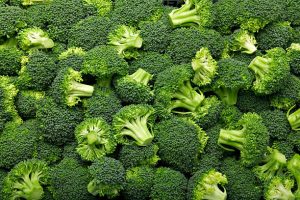
I’m a gardener, and when my own garden isn’t producing what I need, I either go to the local farmers market, or I go to a farm not far from where I live to fill in the rest. The farm is family owned and has been around for years on many acres of beautiful, rich land. When you drive down the road that leads to the entrance, during the summer months there are perfect rows of vegetables sharing space with corrals of resting horses that greet you on the way in. When I see that much healthy produce spread as far as the eyes can see, row after row, I feel rich – not because the produce is expensive, but because it is abundant. This promise of health in the form of real food, to me, is luxury. Unlike processed food-like substances, this food won’t kill you; instead, it gives you life.
I digress – I mean to talk to you about the many benefits of broccoli and some of the other produce in the family of cruciferous vegetables. Aside from broccoli, this group includes vegies like cauliflower, kale, cabbage, garden cress, bok choy, brussel sprouts and mustard. Although they share many wonderful and important qualities, broccoli is the only one of this group that produces sulforaphane.
“One of the most potent natural anti-cancer compounds ever discovered.”
The above quote got my attention; it is referring to a compound found in broccoli sprouts called, Sulforaphane. Broccoli, I discovered, came to this country from the Mediterranean in 1910, only about one hundred years ago, delivered by some Italians. Sulforaphane, this extraordinary compound, was discovered in the early 1990’s, at John Hopkins University, and apparently there are just two ways to consume it: Sprouting broccoli seeds and eating the sprouts or taking a Supplement.
I’ve been sprouting seeds in mason jars since my early twenties, so when I started reading the research on Sulforaphane, I got out the mason jars and cheese cloth and stocked up on organic broccoli seeds. In my enthusiasm, I even gave the seeds to friends, wanting them to share the incredible benefits of this compound; I didn’t realize, however, that most people won’t go to the trouble of sprouting and would rather take a supplement. There are issues with both ways: The seeds must be organic and, even then, may not have an important precursor to sulforaphane – glucoraphanin. This is true for both the sprouts and the supplements. In addition, our gut microbiome must have a particular enzyme – myrosinase – in order to convert the glucoraphanin to sulforaphane; not all of us have this enzyme in our gut microbiome.
In addition, unless you disinfect the seeds, you risk spoiling the sprouts, which can be a potential source of food born illness. To avoid this possibility, the researcher who started all this disinfects his seeds with a 1:10 bleach/water solution, which admittedly, I haven’t tried yet. If you aren’t sure about using bleach on these precious seeds, there are other ways to disinfect them: Try rinsing with such things as vinegar, grapefruit seed extract or hydrogen peroxide. The other option, buying the sulforaphane supplements, can be expensive and there are just a few companies that do it right and produce supplements with the needed precursors.
“Eat food, not too much, mostly plants.” – Michael Pollan
You could also do both, just to cover your bases – make sprouts and take the supplements, along with eating the broccoli plant; you won’t get the sulforaphane eating the plant (that important compound is only in the sprouts), but there are many important properties in the different parts of the broccoli plant, as well as the other crucifers. As the plant grows, it produces important compounds at different stages of the plant’s growth that are used for its protection against possible predators. These compounds are repurposed by us as we eat them, adding to the strength of our own immune system…The broccoli stalks (which I love and peel and eat raw), have lots of soluble fiber; the leaves that grow off the stalk are filled with chlorophyll; the heads are abundant with vitamin C and other nutrients; and, eventually the heads produce flowers that go to seed, where the sulforaphane is finally produced. Then, in order to get the sulforaphane, the seeds are sprouted and consumed.
The Many Benefits of Consuming Sulforaphane
When I hear about something as exciting and important as Sulforaphane, I feel compelled to share it with the people I care about. Why shouldn’t everyone learn about something this exciting that will increase your health span and lifespan? Here are the six benefits that we know of from consuming sulforaphane, …
1). Lowers the risk of cancer: Researchers found that this compound enhances deactivation of carcinogens (like glyphosate), increasing protection from DNA damage, slowing progress of the disease in cancers of the prostate, bladder, breast and colon.
2). Improves detoxification capacity in all three phases of detoxification in every cell. Unlike other antioxidants, like vitamin C, whose effects last for about a day, this compound’s effects last seventy-two hours or more, without buildup.
3). Protects the brain and restores cognition. Encourages formation of new neurons and synapses, increasing Brain Derived Neurotrophic Factor (BDNF), an important protein that enhances healthy brain activity, cognition and nerve growth. Increases BDNF in conditions like: Autism, Alzheimer’s disease, Parkinson’s disease, anxiety, brain trauma, accelerated aging, neurotransmitter dysfunction, obesity and schizophrenia. Also, decreases brain inflammation and improves learning and memory.
4). Decreases generalized inflammation. Modulates joint inflammation.
5). Slows aging. Acts as a potent antioxidant, augments glutathione, the body’s most important antioxidant.
6). Improves cardio metabolic health. Decreases Insulin Resistance, improves glucose tolerance by favorably affecting lipid profiles, regulates the heart muscle, improves endothelial function and improves metabolic disorders – obesity, type 2 diabetes and hypertension.

Risa Potters, D. C.
http://www.thesmartofliving.com/broccoli-and-me/
http://www.thesmartofliving.com/our-vertical-lives/
https://www.instagram.com/drrpotters/?hl=en
https://m.facebook.com/RisaPottersDC/
